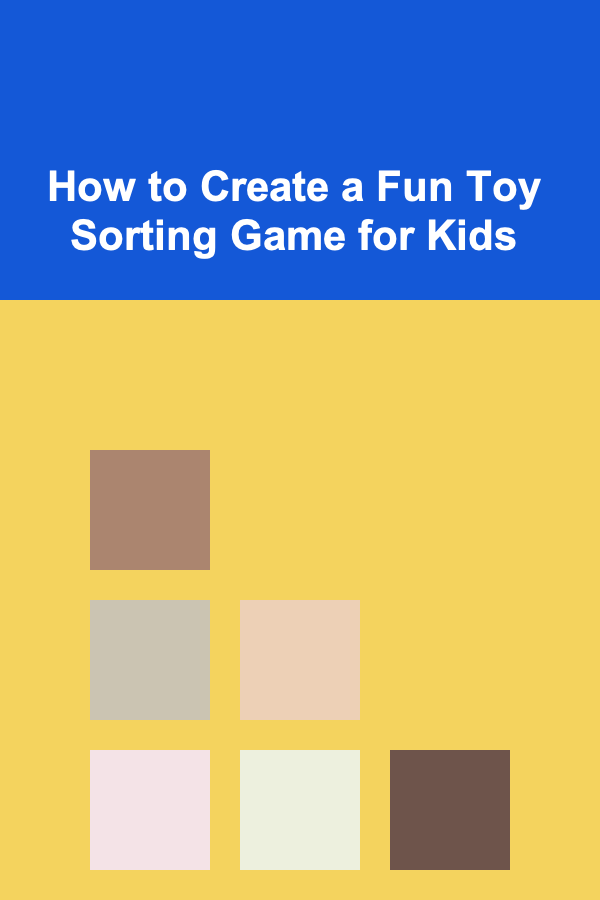
How to Create a Fun Toy Sorting Game for Kids
ebook include PDF & Audio bundle (Micro Guide)
$12.99$5.99
Limited Time Offer! Order within the next:

Creating a fun toy sorting game for kids is not only an enjoyable activity but also a valuable educational experience. Sorting games can help develop a child's cognitive skills, enhance their social interactions, and promote emotional growth. This comprehensive guide will explore how to create an engaging and effective toy sorting game that caters to children's diverse needs and interests.
Understanding the Importance of Sorting Games
Before diving into the specifics of creating a toy sorting game, it's essential to understand why such activities are beneficial. Here are several key reasons:
1. Cognitive Development
Sorting games stimulate critical thinking and problem-solving skills. Children learn to categorize objects based on various attributes, such as color, size, shape, or type, enhancing their ability to analyze and make connections between different items.
2. Fine Motor Skills
Manipulating toys during sorting requires precision and coordination, which can significantly enhance fine motor skills. This physical interaction helps children develop hand-eye coordination and dexterity.
3. Language Skills
As children engage in sorting games, they often describe their actions or the attributes of the toys. This verbal engagement promotes language development, vocabulary enhancement, and communication skills.
4. Social Skills
Sorting games can be played individually or in groups, providing opportunities for social interaction. Children learn to cooperate, share, take turns, and engage in friendly competition, all of which are crucial social skills.
5. Emotional Growth
Participating in games allows children to experience a range of emotions, from excitement to frustration. Learning to navigate these feelings fosters emotional resilience and self-regulation.
Planning the Game
Creating a successful toy sorting game begins with careful planning. Here are the key steps to consider:
3.1. Setting Goals and Objectives
Define the purpose of the game. Are you aiming to improve specific skills, such as sorting by color or shape? Establish clear objectives to guide your planning process. For example:
- Enhance cognitive skills through categorization.
- Promote teamwork and collaboration among participants.
- Encourage independent play and self-directed learning.
3.2. Choosing Suitable Toys
Select a variety of toys that are appropriate for the age group participating in the game. Consider using:
- Blocks: Different colors, shapes, and sizes can provide excellent sorting opportunities.
- Action Figures: Sort by type, size, or character affiliation.
- Animal Figures: Group animals by species, habitat, or color.
- Art Supplies: Sort crayons, markers, and other art materials by color or type.
3.3. Determining Space and Setup
Identify a suitable location where the game will take place. Ensure there is enough space for children to move around freely and engage with the toys. Consider the following setups:
- Indoor Play Area: A spacious living room or playroom with a flat surface for sorting.
- Outdoor Space: A safe, open area where children can enjoy fresh air while sorting toys.
Designing the Game Mechanics
Once you have planned the basics, focus on the mechanics of the game. This includes rules, instructions, and how scoring will work.
4.1. Game Rules and Instructions
Establish clear and simple rules that are easy for children to understand. Depending on the age group, you might want to include:
- Basic Sorting: Children sort toys into designated categories (e.g., colors, shapes).
- Timed Challenges: Set a timer and see how many toys they can sort in a given time.
- Creative Sorting: Encourage children to come up with their own sorting categories, fostering creativity.
4.2. Scoring and Rewards System
Implement a scoring system to motivate children. For example:
- Points for Each Sort: Award points for each correctly sorted item.
- Bonus Points: Give extra points for creativity or teamwork.
- Small Rewards: Consider offering small prizes or certificates for participation or achievement.
Creating Engaging Materials
Materials play a crucial role in making the game engaging and fun. Here are some ideas for creating appealing game materials:
5.1. Sorting Containers
Use colorful bins, baskets, or boxes for sorting toys. Label each container according to the sorting criteria (e.g., colors, types, sizes). This visual aid helps children understand the sorting process better.
5.2. Visual Aids and Labels
Incorporate visual aids to enhance understanding and engagement. For example:
- Picture Cards: Create cards depicting different categories or attributes to aid younger children.
- Labels: Use large, colorful labels for each category to reinforce learning.
5.3. Fun Challenges and Variations
To keep the game dynamic, introduce challenges or variations. For instance:
- Obstacle Course: Create a sorting challenge where children navigate through an obstacle course to collect toys for sorting.
- Theme Days: Organize themed sorting days, such as "Animal Day" or "Color Day," to keep interest high.
Implementing the Game
With the planning and materials ready, it's time to implement the game. Here's how to do it effectively:
6.1. Setting Up the Environment
Prepare the space before the game starts. Arrange the sorting containers and toys neatly, ensuring everything is within reach for the children. Create an inviting atmosphere with decorations or music if desired.
6.2. Inviting Participation
Gather the children and explain the game's objectives and rules clearly. Encourage them to ask questions if they are unsure about any aspect. Make sure to emphasize the fun elements of the game to spark their enthusiasm.
6.3. Facilitating the Game
During the game, facilitate the activity actively. Offer encouragement, provide assistance when needed, and ensure that everyone is engaged. Keep track of scores and celebrate achievements, no matter how small.
Learning Outcomes
Engaging children in a toy sorting game can lead to various positive learning outcomes.
7.1. Cognitive Skills Development
Through sorting activities, children enhance their cognitive abilities, including:
- Critical Thinking: Evaluating and categorizing items develops analytical skills.
- Problem-Solving: Figuring out how to sort items based on different criteria encourages creativity and flexibility.
7.2. Social Interaction and Teamwork
When played in groups, sorting games foster social skills:
- Cooperation: Children learn to work together, sharing responsibilities and ideas.
- Communication: Engaging in discussions about sorting methods encourages verbal expression and social interactions.
7.3. Emotional Growth
Participating in sorting games can contribute to emotional development:
- Self-Regulation: Children learn to manage their excitement or frustration, especially during timed challenges.
- Confidence Building: Achieving sorting goals or receiving praise boosts self-esteem.
Tips for Success
To ensure your toy sorting game is enjoyable and effective, consider the following tips:
8.1. Keeping It Fun and Light
Remember that the primary goal is to have fun. Keep the atmosphere relaxed, and avoid putting too much pressure on children. Celebrate efforts, rather than just achievements.
8.2. Adapting to Different Age Groups
Tailor the game to suit various age groups. Younger children may benefit from simpler sorting tasks, while older children can handle more complex challenges. Adjust rules and categories accordingly.
8.3. Encouraging Creativity
Encourage children to come up with their own sorting methods or categories. This fosters creativity and allows them to take ownership of their learning experience.
Conclusion
Creating a fun toy sorting game for kids is an enriching experience that combines education and play. By understanding the importance of sorting games, carefully planning the activity, and designing engaging materials, you can foster a dynamic learning environment.
Through sorting activities, children can develop essential cognitive, social, and emotional skills while having fun. Remember to keep the atmosphere light and enjoyable, adapting the game to suit different age groups and encouraging creativity.
Ultimately, a well-executed toy sorting game not only enhances learning but also strengthens the bonds between children and caregivers, making it a valuable addition to any playtime routine. Embrace the joy of sorting and watch as children thrive in their newfound skills and creativity!

How to Budget for Emergencies and Unexpected Expenses: An Actionable Guide
Read More
How to Choose Multi-Functional Furniture for Small Rooms
Read More
How to Create an Instagram-Worthy Home Party Setup
Read More
Top Tips for Lowering Car Insurance Premiums Without Compromising Coverage
Read More
What Inspirational Stories Can Motivate You to Organize Your Home?
Read More
How To Master Building a Survival Kit
Read MoreOther Products

How to Budget for Emergencies and Unexpected Expenses: An Actionable Guide
Read More
How to Choose Multi-Functional Furniture for Small Rooms
Read More
How to Create an Instagram-Worthy Home Party Setup
Read More
Top Tips for Lowering Car Insurance Premiums Without Compromising Coverage
Read More
What Inspirational Stories Can Motivate You to Organize Your Home?
Read More